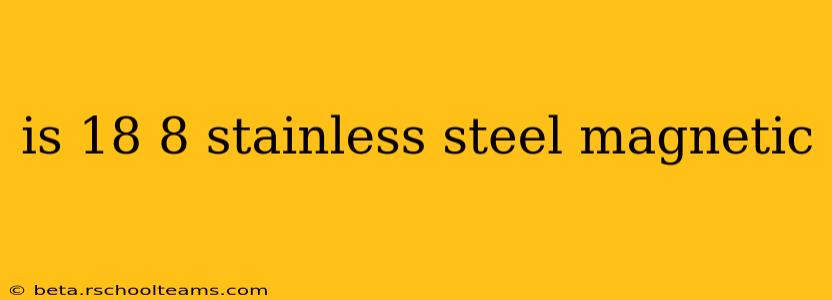The magnetism of stainless steel, specifically the 18/8 type (also known as 304 stainless steel), is a common point of confusion. The short answer is: sometimes. While many people assume stainless steel is inherently non-magnetic, that's not entirely accurate. The magnetic properties depend on the specific composition and processing of the steel.
Let's delve deeper into the reasons behind this variability.
What Makes Stainless Steel Stainless?
Stainless steel gets its "stainless" quality from chromium, an element that forms a protective chromium oxide layer on the surface, preventing rust and corrosion. 18/8 stainless steel refers to its composition: approximately 18% chromium and 8% nickel. These elements are key to its corrosion resistance and many other desirable properties.
Why Some 18/8 Stainless Steel is Magnetic
The key to understanding the magnetism lies in the crystalline structure of the steel. Austenitic stainless steels, like the majority of 18/8 grades, typically have a non-magnetic structure. However, several factors can influence this:
-
Cold Working: Processes that involve significant cold working (like hammering, bending, or rolling) can induce some degree of magnetism. This is because these processes alter the crystalline structure, causing a slight shift that can result in weak magnetic properties. Think of it as stressing the metal. This is the most common reason you find some 18/8 stainless steel to be slightly magnetic.
-
Composition Variations: Even within the 18/8 designation, minor variations in composition can affect the magnetism. Slight deviations from the ideal 18/8 ratio might lead to a material that exhibits weak magnetic properties. Manufacturing processes aren't perfectly precise.
-
Presence of Ferrite: Although primarily austenitic, trace amounts of ferrite (a magnetic phase of iron) can be present in some 18/8 stainless steel. The level of ferrite is usually kept low for optimal corrosion resistance, but its presence can contribute to magnetic behavior.
Why Some 18/8 Stainless Steel is Non-Magnetic
Most 18/8 stainless steel is indeed non-magnetic, or only very weakly magnetic, in its annealed (heat-treated) state. The austenitic structure ensures good corrosion resistance while minimizing magnetic attraction.
What About Other Types of Stainless Steel?
It's crucial to remember that not all stainless steel is created equal. Other types, like ferritic stainless steel, are inherently magnetic. These grades generally contain less nickel and more chromium, resulting in a magnetic structure.
How Can I Test If My 18/8 Stainless Steel is Magnetic?
A simple test using a strong magnet can determine if your stainless steel exhibits magnetic properties. If a magnet strongly adheres to the steel, it's likely a magnetic grade or has been significantly cold worked. A weak attraction may simply be due to cold working. A completely non-magnetic response suggests an annealed, high-purity austenitic stainless steel.
Is the Magnetism a Problem?
In most cases, the weak magnetism exhibited by some cold-worked 18/8 stainless steel isn't a significant issue. Its primary functions — corrosion resistance and strength — remain unaffected. However, if you require a completely non-magnetic material for specific applications (like MRI environments), it's crucial to specify non-magnetic 18/8 stainless steel or a different, entirely non-magnetic alloy.
In conclusion, the magnetic properties of 18/8 stainless steel aren't a simple yes or no answer. Its behavior depends on factors like composition, manufacturing processes, and any subsequent cold-working. Understanding these nuances helps clarify this often-misunderstood aspect of this widely used material.
